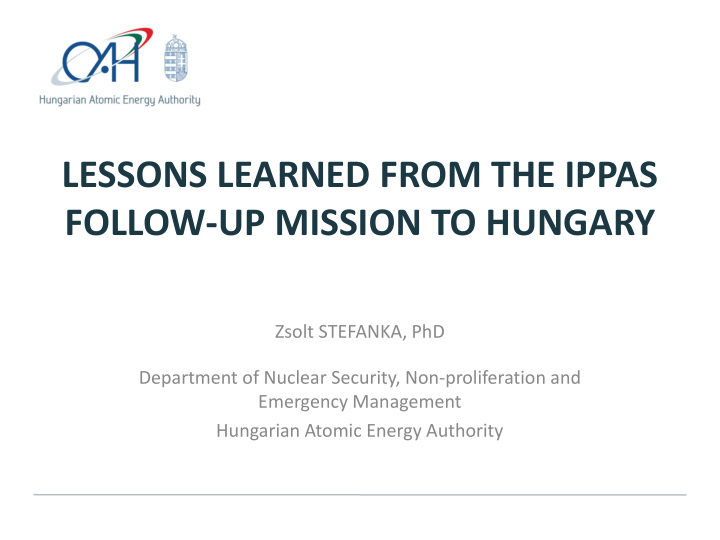



LESSONS LEARNED FROM THE IPPAS FOLLOW-UP MISSION TO HUNGARY Zsolt STEFANKA, PhD Department of Nuclear Security, Non-proliferation and Emergency Management Hungarian Atomic Energy Authority
Background 1997. 1 st IPPAS mission to Hungary 2011. New security regime was established → Govt. Decree 190/2011. (IX. 19.) Korm. on physical protection was promulgated 2012. June → the IAEA received the request of the Government of Hungary to conduct a 2 nd IPPAS mission 2 nd IPPAS mission to Hungary in May – June 2013 HAEA prepared and delivered a package of advance documents including: • detailed overview of the Hungarian nuclear applications • legal system and the regulatory regime • translated versions of the relevant laws, physical protection regulatory guidelines, a sample license and an inspection record 2
Scope of the mission 2013 Review of the Hungarian nuclear security legislative and regulatory framework, regulatory practices (licensing, inspections and enforcement). Review and evaluation of the physical protection systems (Budapest Research Reactor, Central Isotope Storage Facility, Paks NPP and Spent Fuel Interim Storage Facility). Assessment of the physical protection arrangements for transport. Interface with nuclear material accountancy procedures and computer security related issues. 3
Site visits 2013 Paks NPP Training Reactor Spent Fuel Interim Storage Facility (SFISF) Budapest Research Reactor Training Reactor Budapest Research Reactor Radioactive Waste Treatment and Disposal Facility (RWTDF) Institute of Isotopes Co., Ltd. RWTDF Paks NPP Agroster Irradiation Ltd. Hungarian Trade Licensing Office National Institute of Oncology SFISF 4
Results of the IPPAS mission 2013 The IPPAS Team concluded that nuclear security within Hungary has been significantly enhanced in recent years. 9 recommendations 57 suggestions 12 good practices Recommendation Suggestion Good practice Hungarian nuclear security legislative 2 7 4 and regulatory framework Physical protection systems (sites) 6 44 8 Transport 1 6 - Part of the mission report is classified, but national review part is publicly available. 5
Activity between 2013-2017 National Action Plan was developed based on the IPPAS Report National Action Plan Action Plan of the HAEA Action Plans of the Licensees Separate Regulatory Decisions with determined deadlines were issued to obligate the licensees to complete their planned actions. 6
Preparation of IPPAS Follow-up 2015 June → the IAEA received the request of the HAEA to conduct an IPPAS Follow-up mission 2017 May → Advance Information Package was prepared and delivered IPPAS Follow-up mission 26 June-7 July 2017 Objectives of the follow-up mission : Assess the implementation of the recommendations and suggestions provided by the 2013 IPPAS mission Review the current status of the national nuclear security regime of nuclear and other radioactive material, associated facilities and associated activities Review the current status of nuclear security measures, including nuclear material accountancy and control , at Paks NPP and at RWTDF 7
Scope of the IPPAS Follow-up Nuclear security legislative and regulatory framework for nuclear and other radioactive material and associated facilities Regulatory practices (licensing, inspections and enforcement) Coordination between organisations involved in nuclear security Computer security Current physical protection systems at: Paks NPP RWTDF Security arrangements concerning the construction of planned two new units of Paks II Nuclear material accounting and control for security (using draft IPPAS module 6) at state level and at the facilities 8
Conclusions of IPPAS Team All 9 Recommendations have been CLOSED 56 of 57 Suggestions have been CLOSED Significant Accomplishments: Placing Radiation Protection under the competancy of HAEA Improvements to Government Decrees Further development of Computer Security Programs Revision of Regulatory Guides, including for lost/stolen radioactive sources 9
Conclusions cont ’ d Results : 4 new recommendations 20 new suggestions 10 new good practices The State continues to improve its Physical Protection Regime from a high bar National level legislation and regulations are in line with related international conventions (A/CPPNM) and IAEA ’ s recommendations (NSS 13, also INFCIRC/225/Rev.5) Well integrated system of security, safeguards and safety 10
Conclusions of IPPAS Team Facility level - Paks NPP All recommendations and suggestions from 2013 IPPAS mission are implemented and can be considered CLOSED Significant Improvement since 2013 Comprehensitve nuclear security culture Program Further development of computer security is required Results : 1 New recommendation 4 New suggestions 2 New good practices 11
Conclusions of IPPAS Team Facility level - RWTDF Püspökszilágy RWTDF low and intermediate level radioactive waste All recommendations and suggestions from 2013 IPPAS mission have been implemented and can be considered CLOSED Significant security upgrades have been applied Overall security exceeds IAEA guidance Results : 1 New recommendation 2 New suggestions 1 New good practices 12
Summary The IPPAS Team concluded that Hungary has a well established nuclear security regime and made significant improvement since the previous 2013 mission. Final report has received by HAEA at the end of September. 13
Special thanks to my colleagues: Árpád VINCZE, Zsófia SZEPES, Armand VIPLAK, Viktória HÓDOSI and Thank you for your kind attention!
Recommend
More recommend